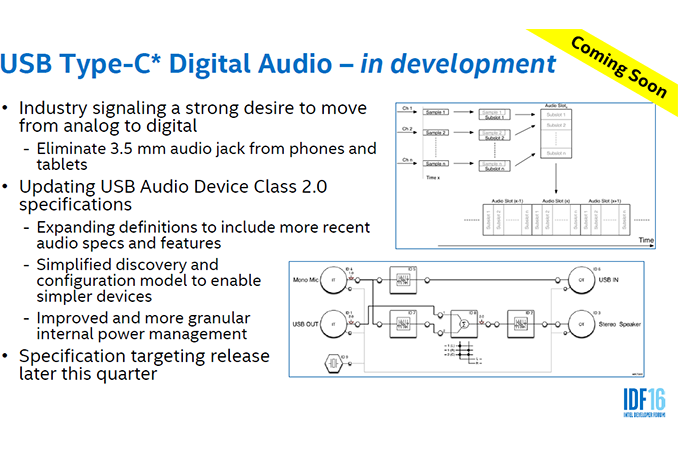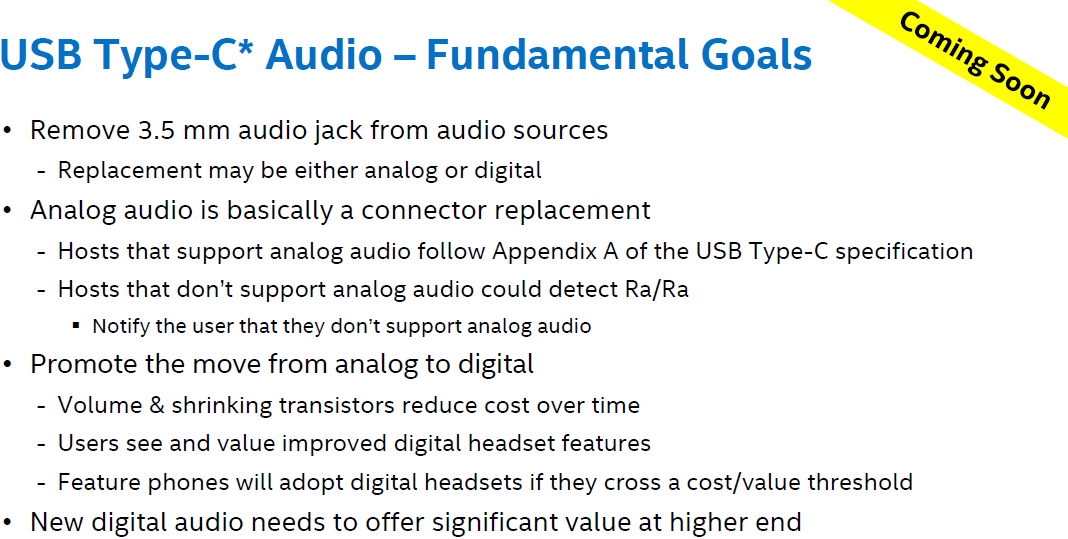Intel Proposes to Use USB Type-C Digital Audio Technology
by Anton Shilov on April 26, 2016 11:00 AM EST- Posted in
- Mobile
- Intel
- USB-C
- USB-C Digital Audio

USB Type-C has a number of chances to become the standard for data and charging connector for smartphones and tablets running either Android or Windows. However, in the long-term future, Intel wants USB-C to be even more universal (and therefore pervasive) than it is going to be, which is why at IDF Shenzhen part of one of the talks evolved around using Type-C for audio.
Audio receptacles on PCs and mobile equipment are virtually the last remaining analog interfaces of modern devices, requiring certain techniques to maintain a high audio quality and remove interference. Intel proposes to replace things like 3.5 mm mini-jack with USB Type-C which will help to add features to headsets and will simplify connections of multi-channel audio equipment to various gadgets. This is not the first time a company has proposed to replace analog audio on PCs and mobile devices, but so far, nobody has succeeded due to the ubiquity of 3.5mm. Since the industry may still not be ready to go all-digital, there seems to be a backup plan.
Various types of audio jacks to connect headphones to audio equipment have been around for decades. For example, the original 6.35 mm connector, which is still widely used by audio equipment, was invented in 1878. Meanwhile, two-conductor miniature 3.5 mm audio connector (which is the most widely used audio connector at present) has been around since 1960s. Headphone jacks have evolved; they have gained contacts to support microphones and even basic programmable capabilities to enable remote controls. However, fundamentally, the ability to listen to audio through a speaker has remained the same for over a hundred years: completely analog and barely any smart functionality. Today's smartphones are used for all sorts of different purposes and are connected to a variety of devices, which requires sophisticated interconnection technologies with high data-rates. At the same time, as phones and devices get thinner, or even to simplify some of the internal design, it gets harder to install multiple ports for various purposes. If there were to be a universal connector that does it all, including audio, Intel and some other players want USB Type-C to be that universal connector.
In fact, USB-C can be used to transfer analog audio in accordance with the specification of the connector. It all comes down as to how that audio is transmitted.
The USB-C has sideband use pins (SBU1 and SBU2) which can be used for analog audio in audio adapter accessory mode. Use of the sideband pins should not impact data transfers and other vital functionality of USB-C cables, which should make them relatively simple from the engineering point of view. In this case, the USB-C connector will just replace the 3.5 mm mini jack and may even gain some additional features, such as a thermal sensor in an earpiece could measure temperature for fitness tracking.
The concept is not completely new and we saw it years ago - back in the 2000s, Motorola used the mini-USB connector on its feature phones to enable charging, data transfers and a headset connection. The idea to use one connector for everything was not entirely bad, however, it left users without a choice of headsets. However, if the makers of devices (as well as producers of audio listening equipment) adopt USB-C, the is potential that the problem will not occur again. In the advent of digital signal transfer, this allows the headset to drive the digital-to-analog conversion, removing electronic interference from the host and potentially offering a wide array of audio results.
However, transferring analog audio using USB-C’s SBU pins is not the only thing that Intel is working on.
At present, Intel is finalizing the USB Type-C Digital Audio technology and plans to release its specification later in Q2. The company does not reveal a lot about the standard right now, but notes that it is working on updating the USB Audio Device Class 2.0 specifications to support new connector, expand the list of recent audio specifications and features, improve power management and simplify the discovery and configuration model to make the upcoming headsets as easy to use as today’s headsets.
In fact, one of the important issues with streaming audio over USB is the synchronization of data streams from the host to the receiver. The USB Audio Device Class specification solved the problem in the past and because Intel mentioned the USB Audio Device Class 2.0 in its presentation at IDF, this may mean that the new the USB-C Digital Audio spec will rely on this synchronization mechanism as well. Intel wants its USB-S Digital Audio to be backward-compatible with USB Audio (1.0 and 2.0), but naturally plans to add support for new music formats.
Usage of digital audio means that headsets should gain their own amplifiers, DACs and various other logic, which is currently located inside smartphones. Intel proposes to install special multi-function processing units (MPUs), which will perform beam forming, noise suppression, acoustic echo suppression (AES), acoustic echo cancellation (AEC), non-linear processing and other operations. The MPUs will also support HDCP technology, hence, it will not be possible to make digital copies of records using USB-C digital headset outputs. It is unlikely that audio processing will be offloaded to external headsets completely, but the latter will clearly gain their own chips. This may, however, see a spike in cost, especially at the super-low end.
A good thing about USB Type-C headsets with MPUs is that they are going to be software upgradeable and could gain functionality over their lifespan. Intel admits that such MPUs will make digital headsets more expensive compared to analog devices, but high volumes and new process technologies will help to reduce the cost of digital headsets over time. In fact, USB Audio headsets and audio chips for them are not something completely new. For example, Plantronics Audio 655 DSP headset costs $49.99, whereas CMedia’s HS-100 chip for headsets is available $1. Therefore, from the cost perspective, digital headphones should not be too much more expensive in general. Meanwhile, Intel wants USB-C digital audio headsets to offer “significant value at higher end” and have improved functionality in a bid to become popular among consumers.
The industry has successfully replaced analog cables with HDMI for video equipment in the living room and in the coming years will retire the D-Sub interconnection for computer displays. However, audio jacks have survived multiple generations as other standards have changed. In fact, Intel itself eliminated analog audio jacks in its first-generation NUCs PCs, but had to return them in subsequent generations. With USB-C Digital Audio Intel may not be alone. Google’s Android 5.0 already supports USB DAC devices and thus digital headsets. Moreover, last week LeEco released several smartphones without audio jacks, so, there are attempts to eliminate them from mobile devices already. One maker will not make any difference, but a coordinated move by market leaders, such as Samsung, LG or HTC, could have a significant impact.
Source: Intel



















148 Comments
View All Comments
rbanffy - Wednesday, April 27, 2016 - link
Mechanical loads will be an issue. When my phone is in my pocket, the analog headphone plug is subjected to forces from various directions. I doubt a USB-C connector, which is relatively short can have the kind of mechanical robustness the analog TRRS connector offers.ingwe - Wednesday, April 27, 2016 - link
This is a very good point. I didn't consider this, but it is huge. If consumers are constantly breaking their new headphones, this will be DOA.haukionkannel - Wednesday, April 27, 2016 - link
Good point...What I am concerned is the audio quality. Can I use why very hard to drive HiFi quality headphones aka 1000$, piece of craftsmanship with this new usb port and get enough power to use them?
If audiophiles will be ok, with this, well maybe. But if it is worse than old, or only as good as the old... Why buy new headphones? By headphones will last next 15-25 years and stil be good quality. My phone will be old junk in few years. The usb port will chance to new version if every 2-4 years. The next usb version could be based on light. How it will be compatible with usb-c headphones? I doubt very much!
WaitingForNehalem - Wednesday, April 27, 2016 - link
What a pointless and desperate attempt to make more money...alexandru512 - Wednesday, April 27, 2016 - link
Another problem will be when USB will be replaced with another standard. Then WHAT? Do you think USB-C will last more that a few years?boeush - Wednesday, April 27, 2016 - link
The answer is as it always has been in the past: adaptors.boeush - Wednesday, April 27, 2016 - link
There are some potential benefits to this approach, which most of the skeptical commenters here have apparently failed to appreciate.First, a wired connection provides power to the headset - and thus such headsets are inherently lighter, more compact, and cheaper than wireless ones, because they don't have to incorporate a battery, a radio, charger and power management circuits. If your phone is plugged in while you are listening (assuming USB Daisy chaining or two ports - e.g. on on top and one on bottom of phone), you can listen forever whereas a Bluetooth headset will run out of juice. A powered headset can also opt for more power consumption (e.g. higher volume, better DSP) without worrying about draining the tiny internal battery of a wireless headset.
As far as digital signalling goes, it means you can use a high-quality headset on a cheap/crappy phone and still achieve high-quality sound. You are also not limited by length or shielding quality of cable when it comes to distortion/noise. Onboard DAC also means the headset can do its own equalization to match the specific parameters of its driver and acoustic chamber design - thus allowing a more nearly 'perfect' (e.g. spectrally flat) performance from less 'perfect' (e.g. cheaper!) designs. It also means potential for tunable EQ on the headset, that travels with the headset (independently of what you plug it into.)
And as mentioned in the write-up, there is additional potential for extra data to/from the headset - which is a nice bonus.
boeush - Wednesday, April 27, 2016 - link
One other thing. Current analog headphone audio is by design limited to stereo-only. But imagine a digital 5.1+ channel signal being sent to headphones. They could do their own design-specific conversions to simulate surround sound as accurately as possible. Or they could even incorporate multiple drivers (e.g. one bass/midrange/subwoofer driver surrounded by a ring of tweeters) and use delay/beamforming algorithms to actually reproduce more or less the exact sound wavefront you'd get at your ear from actual surround-sound speakers. Imagine carrying a surround-sound system on your head everywhere you go. Something utterly impossible with analog headphones, but entirely possible with digital ones - and will mesh nicely with VR as well...ddriver - Thursday, April 28, 2016 - link
You only have 2 ears. You only need 2 ear cups. You only need two channels. The human doesn't have multiple ears, only 2, and the human perceives "surround" sound because of how sound changes as it travels around the head. This can be achieved 100% in software without requiring additional channels.To put it in an analogy, multi channel surround for headphones is like instead of screwing in a lightbulb with your hand, you are standing on a chair and 4 guys are rotating the chain with you so the bulk can get screwed in.
Daggoth - Thursday, April 28, 2016 - link
Not to mention that what he is describing already exist on PC, and surely isn't the choice of someone searching for high quality audio